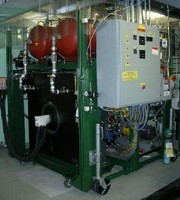The technology to make hydrogen production economical is just one year old.
While commercial-grade fuel cells for back-up electrical power have been on the market for a decade, the power source they need has been prohibitively expensive.
This is why fuel cell cars remain experimental.
GE Research won an award for its breakthrough, from Popular Mechanics, just last November. The concept was to replace metal parts in an electrolyzer, which uses electricity to separate hydrogen from oxygen, with a GE plastic called Noryl. The plastic was electroplated to form the electrodes needed for the process.
The picture of GE’s prototype electrolyzer is from the Popular Mechanics blog.
According to GE, its new design means hydrogen can be produced at a
price equivalent to that of gasoline today. Transportation and storage
remain major challenges. Conversion of hydrogen to ammonia is one
possible solution, but this too costs money and energy.
The point today is breakthroughs like this are happening all around the
world. If the work can be coordinated, collated, and driven forward, if
knowledge in this area can be pooled, we can create the hydrogen
economy in time to save the planet.
I can do a little of this work, on this blog, and I hope you’ll join me
on the search. But serious resources need to be brought to bear, and
soon.













Just a correction: the electrodes in the GE design are not plastic, they are still metal. They’re actually just stainless steel with a very cheap but high- effective surface coating on them. GE saved most of the cost by replacing all the NON-electrode parts, which have a lot of complicated passages in them, with plastic.
Just a correction: the electrodes in the GE design are not plastic, they are still metal. They’re actually just stainless steel with a very cheap but high- effective surface coating on them. GE saved most of the cost by replacing all the NON-electrode parts, which have a lot of complicated passages in them, with plastic.